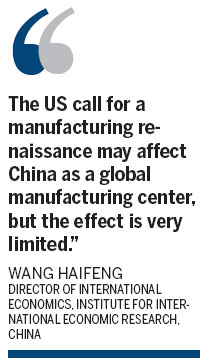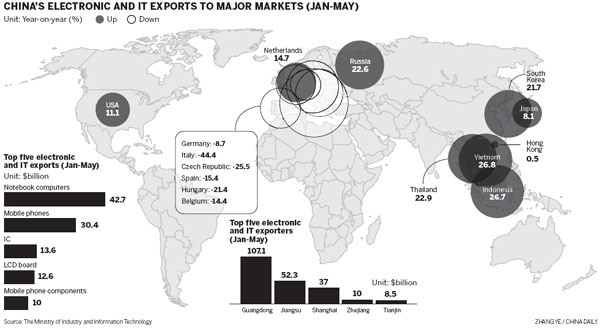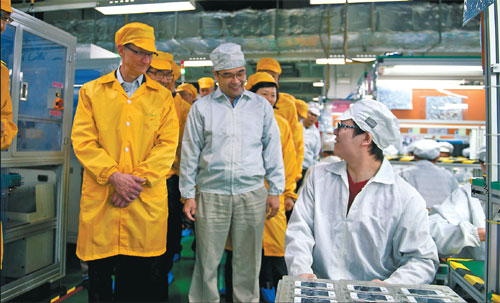Homeward bound? Firms mull return
|
Tim Cook (left), chief executive officer of Apple Inc, visiting the iPhone production line at the Foxconn Technology Group facility in Zhengzhou, in Central China's Henan province. Apple Inc now outsources most of its manufacturing to Taiwan-based Foxconn. Provided to China Daily |
Rising labor costs and cheaper US energy drive some companies back
It has taken 25 years to evolve from the brick-like dageda (big brother's handset) to the slim iPhone currently in vogue.
The first mobile phone, the Motorola 3200, entered the Chinese market in 1987 and marked the start of a craze that now sees them in nearly everyone's possession.
It is similar for other electronic products that first made their way to China from foreign companies and then began to be produced here en masse because of the country's huge and relatively cheap labor.
Soon the Middle Kingdom became the global manufacturing center after Japan. A random search of electronic products on a retailer's shelves now inevitably reveals "Made-in-China" labels or, at least, components produced in the country.
Now, however, some overseas companies are considering moving their manufacturing facilities out of China.
Heading home?
When US President Barack Obama joined Silicon Valley's top luminaries for dinner in California in early 2011, he asked the late Steve Jobs, the founder of Apple Inc, what it would take to start assembling iPhones in the United States.
Jobs' answer was quite straightforward and might have disappointed Obama. "Those jobs aren't coming back," he said, according to another dinner guest. However, one year on and after Jobs' death last year, Tim Cook, his successor as Apple's chief executive officer, gave Obama a more positive reply.
Cook said in a May interview in Rancho Palo Verdes, California, that he wanted the cellphones to be manufactured in the US. Although it would not be easy to achieve the goal, it was a clear hint that it may come to pass. And it fitted in with Obama's call for corporate America to reduce manufacturing outsourcing overseas, especially to China.
Some US companies have been on the move. The Michigan-based Whirlpool Corp, the world's No 1 home appliance maker with sales of $19 billion last year, brought back production of its KitchenAid hand mixers to the US. For the previous six years, a contractor in Huizhou, South China's Guangdong province, made them.

Company Chairman and Chief Executive Officer Jeff Fettig said in order to fulfill the company's commitment to produce in the US and cater to local customers' needs, Whirlpool decided to move some product lines back to the US.
The shift created a net gain of about 25 job opportunities in the US, the Wall Street Journal reported. In contrast to Whirlpool's total 68,000 employees across the world, the figure is tiny.
General Electric Co plans to invest $1 billion by 2014 to upgrade product lines and create new factories for items not previously made in the US. The company is about to add hundreds of employees to its sprawling Appliance Park operations in Louisville, Kentucky, this year.
Similar moves by Otis Elevator Co, Caterpillar Inc and Ford Motor Co, have created a few thousand more positions in the US.
The examples above may be just a beginning. According to findings by the Boston Consulting Group, more than a third of US-based manufacturing executives at companies with sales greater than $1 billion are planning to bring back production to the US from China - or are considering it.
BCG predicted that improved US competitiveness and rising costs in China will put the US in a strong position to add 2 to 3 million jobs in a range of industries and an estimated $100 billion in annual output by the end of the decade.
Companies in seven industries - transportation goods, appliances and electrical equipment, furniture, plastic and rubber products, machinery, fabricated metal products and computers and electronics, are most likely to be among the first to bring back production to the US, according to the BCG report.
It predicts approximately 5-15 percent of goods that the US imports from China could shift to the US before the end of the decade.
After a 35 percent decline in the number of manufacturing jobs between 1998 and 2010, an American manufacturing renaissance may help the US to restore some lost jobs. The number of manufacturing jobs will climb 3.2 percent this year compared with a 1.6 percent increase in all jobs, according to research firm IHS Global Insight.
Labor costs
The rising cost of labor in China is one of the main reasons that prompted US companies to rethink its manufacturing choices. In the BCG survey conducted in February, 92 percent of respondents said they believe that pay in China "will continue to escalate" and 70 percent agreed that "sourcing in China is more costly than it looks on paper".
Foxconn Technology Group, which manufactures Apple's iPhones and iPads, said in February that it would raise the wages of its Chinese workers by 16 to 25 percent, with monthly pay starting from 1,800 yuan ($286). It is the third pay increase by the company since 2010, when the monthly salary was 900 yuan.
According to the 2012 Asia Pacific Salary Budget Planning Survey issued by Towers Watson, a human resource consultant, respondents from China are planning to increase wages by 8.8 percent this year, while some developed markets such as Singapore and Japan are budgeting salary increases of about 3 to 5 percent.
In contrast to China, US employers are likely to cut costs - because of falling energy prices.
Analysts estimated that the US is going to benefit greatly from its rich reserves of shale gas, an alternative energy, and its early exploration work in the field, which helped the nation become the top producer globally of the resource.
An analysis by PwC consultants found that full-scale and robust shale gas development would likely have a number of knock-on effects for the manufacturing sector in the US, reducing natural gas expenses by as much as $11.6 billion annually through 2025.
William Strauss, a senior economist at the Federal Reserve Bank of Chicago, said the boom has meant US electricity prices are the lowest of any industrial nation in the world. The development could help the country lure back work sent to Asia over the years where low-cost labor has been the attraction.
Strauss said labor is still cheaper overseas but the total production costs can be higher after allowing for energy bills and the cost of shipping goods across the Pacific Ocean.
US manufacturing companies could employ approximately 1 million more workers by 2025 due to benefits from affordable energy and demand for products used to extract the gas, the PwC report said.
Costs are not the only factor in the equation. US politicians and corporate leaders have made repeated calls for the shift to inject vitality into the stagnant US economy.
Andrew Liveris, chairman and chief executive officer of Dow, one of the biggest manufacturing companies in the US, said in a speech at Michigan State University last year that innovation follows manufacturing closely and, without production, the US will gradually lose its source of innovation.
"Why should it matter that my iPad says 'built in China' when it also says 'designed in California'?" asked Liveris. If you outsource it, other countries start making devices, build research and development centers and universities around that industry to generate the human and intellectual capital to sustain it, upgrade it and then design the next generation of devices, he said.
"So you start by outsourcing production... and end up outsourcing creativity," he added, saying that, at the same time, it hurt the home market because one "cannot sustain innovations in locations without a production base".
China still attractive
It is clear that changes are afoot for the "Made-in-China" model, but there is no massive production shift from China to other developed countries so far. China remains a favored investment destination for companies in the US, Europe and Japan, analysts said.
Susan Helper, an economics professor at Case Western Reserve University in Cleveland, Ohio, said that factors such as energy costs are making the US a more attractive place for manufacturers, but the numbers of jobs coming back to the US from Asia and Mexico have been small.
"What we have seen is when there is a new plant to be opened, management are now thinking where it should be, instead of automatically choosing China as the default decision," David Lee, a partner at BCG and head of the firm's China industrial goods business, said.
Geoff Li, a spokesman for GE, said GE emphasized both China and the US for manufacturing operations.
"As a technology-driven company, our decisions to invest in manufacturing, service and innovation centers are driven by a number of factors," he wrote in an email reply to China Daily. These include local market potential, GE's ability to service large local customers, the suitability of skills and education, the physical infrastructure and the legal and policy environment.
China is one of the most important manufacturing bases for GE and the company will maintain its overall manufacturing presence in China with expansion plans for some businesses, he said.
Sweden's Telefon AB L.M. Ericsson, the world's biggest telecom equipment maker, started manufacturing in China in 1992 and has built its largest production and supply hub in the world in the Eastern Chinese city of Nanjing.
About 40 percent of Ericsson's total global equipment is made in Nanjing. Melody Li, spokeswoman for Ericsson China, said Ericsson has found no reasons to shift manufacturing to its home market or other developed economies.
"We have benefited from the complete industry chain and sufficient capabilities of our suppliers in China's Yangtze River delta and Pearl River delta," Li said.
China's neighbor, Japan, also invests heavily in China's manufacturing industry, especially in cameras. Canon Inc, Sony and Nikon all have production plants in China.
"The US call for a manufacturing renaissance may affect China as a global manufacturing center, but the effect is very limited," said Wang Haifeng, director of international economics at the Institute for International Economic Research, which is affiliated to the National Development and Reform Commission.
The US advantages lie in middle- to high-end manufacturing, such as precision instruments, aviation and the telecommunications sectors, rather than in what China is specialized at now, he said.
"It is not likely that the low-end labor intensive manufacturing will go back to developed countries because it is not their comparative advantage nor what they are good at," he added.
The center of the global manufacturing industry has moved three times in the past centuries, according to Chen Wenling, chief economist with the China Center for International Economic Exchanges, a top think-tank.
The center used to be in Europe, mainly in the United Kingdom, Germany and France, with UK-made goods taking up two-thirds of global manufacturing volumes in the middle of the 19th century. The US then overtook Europe by World War I and, when World War II was over, US foreign trade volumes accounted for more than one-third of the world's total.
Asian dragons
The second transfer took place from the 1960s to the 1980s when Japan and the "Four Asian Dragons", referring to the highly developed economies of Hong Kong, Singapore, South Korea and Taiwan, replaced the US as the global manufacturing center. Japan then became the biggest producer of vehicles, steel and fiber.
That was followed by a gradual transfer of manufacturing to emerging markets, including China, India, Brazil and Russia. China, known as the world's factory for a long time, accounted for about 20 percent of global manufacturing in 2010.
If production returns to developed countries and even cheaper nations such as Vietnam and Indonesia, the manufacturing sector in China will face challenges.
The good news is China's manufacturing is also moving up the value chain, said Wang Haifeng at the Institute for International Economic Research. He recalled in the past that China mainly assembled imported parts of a product because it was unable to make the parts on its own. But now it can make a large number of things it couldn't in the past, for example, optical glass.
Meanwhile, China has its own advantages in attracting manufacturing businesses. The country will continue to be a manufacturing hub for many sectors, such as electronics, Lee at BCG said.
Take mobile phone production as an example. China is the world's biggest manufacturing base for the devices. The nation shipped more than 1.13 billion handsets in 2011, accounting for about 71 percent of the total number in the world, according to the Ministry of Industry and Information Technology.
In the southern coastal city of Shenzhen alone, approximately 70 percent of made-in-China mobile phones were manufactured, said Sun Wenping, secretary-general of the Shenzhen Mobile Communications Association.
"It is because of the unparalleled mobile-device production chain in China that no other countries can compete with it. Suppliers for mobile phone parts are almost next door," Sun said.
Unlike Apple, which probably takes a year to research and test a new model, Shenzhen's mobile-phone manufacturers have a much higher productivity rate.
"From the idea to the actual product hitting the market, the fastest Shenzhen producers only need 20 days," Sun said.
Gao Yuan contributed to this story.
Contact the reporters at shenjingting@chinadaily.com.cn

(China Daily 07/23/2012 page13)



















